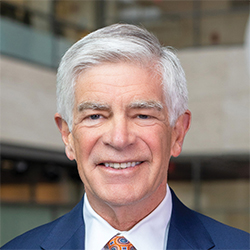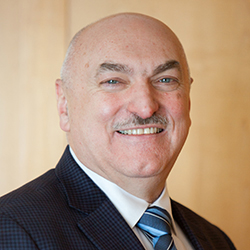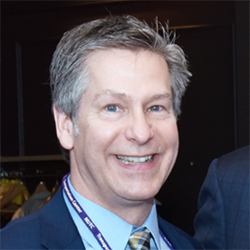The Bond Between Engineering, Infrastructure, and Economics
Patrick T. Harker spoke at the Leon N. Moses Distinguished Lecture in Transportation
Yes, Patrick T. Harker is the president of the Federal Reserve Bank of Philadelphia, playing a major role in shaping the country’s monetary policies. But Harker began his career as an engineer, and that way of thinking hasn’t left his mind.

“As an economist, and especially as president and CEO of the Philadelphia Fed, my goal is to ensure a stable economy that provides opportunities for everyone to grow and succeed,” Harker said. “As an engineer, and specifically as a civil engineer, my goal is to ensure a safe, reliable, and stable infrastructure, which provides opportunities for all communities to grow and succeed.”
The infrastructure of our country, Harker said, is at a pivotal moment. And to make this moment a positive, Harker suggested economics should value infrastructure the way former Northwestern Engineering leader John Hayford envisioned.
Harker shares this view with Hayford, who helmed Northwestern’s College of Engineering in the 1920s. To make his point, Harker read from a 1917 Hayford essay in the Journal of Political Economy titled “The Relation of Engineering to Economics.”
“Economics and engineering are closely related,” Harker read. “Economics has been defined as the social science of earning a living. With the same appropriateness, engineering may be defined to be physical science applied to helping groups … to make a better living.”
The Federal Reserve has a dual mandate to uphold: price stability and maximum employment. Neither, Harker said, are possible without engineering for modern transportation infrastructure.
Modern transportation infrastructure is still a work in progress.
In the 1950s, the US built the Interstate Highway System, a mammoth task that connected all corners of the contiguous states. Since then, the country has not undertaken such a challenge, instead choosing to maintain its current infrastructure, with the recent collapse and rebuild of a portion of Interstate 95 in Philadelphia a strong example.
That episode of quick action, however, was a bit of an exception to the rule of needing to get around red tape to make something happen. And maybe it could be a turning point.
“I could argue that the way many have traditionally looked at infrastructure is much akin to the old Oscar Wilde line about those who “[know] the price of everything and the value of nothing.” We’ve become very good at knowing how much a project will cost, but we haven’t been as good at explaining the value of a project — the long-range economic and quality of life benefits inherent in it,” Harker said. “And so, I would say this is not just a time for us to get better at fixing, but a time for us to take a fuller stock of the results of what we built in the first place and the long-term implications of what we may build in the future.”

Harker delivered the talk “Fulfilling John Hayford’s Legacy: Moving Economics Toward a New Way to Value Infrastructure” at the 2023 Leon N. Moses Distinguished Lecture in Transportation, held November 8 at the Kellogg Global Hub. Hosted by the Northwestern University Transportation Center (NUTC), the lecture honors the late Professor Leon N. Moses, a former NUTC director and renowned researcher of transportation economics and regional science.
Hani Mahmassani, director of the NUTC, William A. Patterson Distinguished Chair in Transportation, and professor of civil and environmental engineering, introduced Harker. During his remarks, Harker argued that infrastructure’s benefits should be valued in greater totality, especially the benefits to those who are situated near these projects.
“The necessary repairs will still be done, and projects already begun will continue. But progress is something for which America has always been known,” Harker said. “And the more we take our eyes exclusively off the costs of a project to the overall economic benefit of a project, the more we will see that price tags, while important, aren’t the only thing to consider.
“We can still, if we take the research into consideration, make Oscar Wilde proud.”
Supporting Supply Chain Systems
 Bret Johnson
Bret Johnson

Earlier in the day, the NUTC and the Center for the Commercialization of Innovative Transportation Technology (CCITT) hosted an industry technical workshop. Co-chaired by Mahmassani and Bret Johnson, director of the CCITT and senior associate director of the NUTC, the event gathered industry leaders to share their companies’ implementation of technology, and take part in a panel discussion moderated by Teradata senior partner Frank Bush.
One common thread was that technology is helpful but will not overcome bad processes.
“I think most customers that I talk to think the technology is like the ‘easy’ button in the old Staples commercials. It’s not going to be that way,” said Nick Martin, vice president of customer success at Coupa Software. “You still need people, you still need good systems, and you need people who also know when to go around the system and not use the technology.”
Other presenters were:
- Kelly Decker, senior director of platform engineering, Schneider
- Danesha Marasinghe, industry consultant – supply chain, Teradata
- Danielle Prigge, senior vice president of sales, Mastery Logistics Systems
EDITOR’S NOTE: The views expressed by Harker are his own and do not necessarily reflect those of anyone else on the Federal Open Market Committee or in the Federal Reserve System.